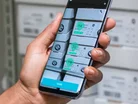Digitising the reordering process in manufacturing

Christian Floerkemeier, CTO at Scandit, knows why manufacturers should digitise their recording processes. Here’s his four reasons why…
Manufacturers are grappling with the issue of how to meet the booming demand for digital e-commerce. In fact, according to a Salesforce study, nearly 1 in 3 B2B organisations report that 50% of their overall revenue comes from digital channels and 55% expect that will become the case within the next few years. Change has arrived, making it all the timelier that manufacturers expand their offerings, ultimately creating a more B2C experience for B2B buyers.
CPG and pharma manufacturers must provide their B2B buyers with a frictionless reordering process to increase revenues and spend time on higher-value tasks. The last year has been the catalyst for changing buyer habits and, in turn, made it more important to offer product reordering as an e-commerce service.
Traditionally, salespeople helped customers to place B2B orders, whereas now e-commerce provides efficient self-ordering. Modern customers don’t require the same sales relationship – so how can this frictionless process be facilitated?
Here are four reasons why manufacturers should use technology to future-proof their business and streamline operations.
Digitalise the ordering process
A poor digital ordering process can impact a manufacturer's bottom line, leading to abandoned online baskets, lost revenues, and more costly demands. It’s important to look towards a smarter solution.
A recent McKinsey survey showed that digital interactions have been twice as important to B2B customers since the pandemic struck. This is why enabling B2B customers to reorder products more efficiently has become a vital element of a manufacturer’s B2B e-commerce strategy.
As too has the investment to unburden sales teams from low-value work. In a Salesforce study, ‘State of Commerce’, 63% of respondents reported that e-commerce has freed their sales teams from the logistics of order processing and allowed them to become strategic advisors.
This is why it’s essential to look towards web or app-based reordering on smart devices. This provides an easier way to make the ordering process leaner and more convenient for product buyers. By digitalising the process, manual processes and ordering errors are eliminated.
Drive fast and frictionless reordering
Integrating scanning technology with existing e-commerce solutions removes the need for manual ordering while offering flexibility and speed for customers and the freedom from costly maintenance visits for the manufacturers.
CPG manufacturers face a crucial challenge, particularly with high frequency stores, by adopting new technology for reordering products. What drives adoption is ensuring they have the same B2C frictionless experience they are used to in their personal lives when ordering B2B products from manufacturers.
The key difference being B2C customers are more prone to one-off purchases, while B2B customers place larger volume or more specialised orders, often as repeat business and as part of their everyday role. This increases the importance of a frictionless experience.
Deliver seamless and straightforward self-service
One thing we know for sure is that convenience is critical to driving user adoption. This means minimising irritation in the buying process, removing the frustration of labour-intensive bottlenecks in product ordering through mobile scanning technology.
Convenient and easy-to-use digital self-service is the expected standard for B2C customers. Unfortunately, the same can’t be said for B2B customers, where time-sapping and manual reordering processes are traditionally the norm, often facilitated by a sales representative.
To combat this, B2B buyers can use the smartphone in their pockets. With a smart device, they instantly have mobile ordering at their fingertips and can order products on the go, whether on the shop floor or in a warehouse. It eliminates the need for catalogue searches or offline orders.
Display product insight to boost basket sizes
Before the disruption caused by COVID-19 and ongoing supply chains issues, it was not unusual for sales representatives to be asked about product stock levels. The global pandemic has led to customers becoming keener to understand the availability of certain products.
Utilising barcode scanning that delivers a world of information at the buyers’ fingertips is a sure-fire way to boost order volumes.
Without a digital link to stock level information, it is tricky for a salesperson to answer and even harder for the customer to find out themselves. Furthermore, stock levels can change rapidly, meaning stock information given to customers may quickly go out of date.

